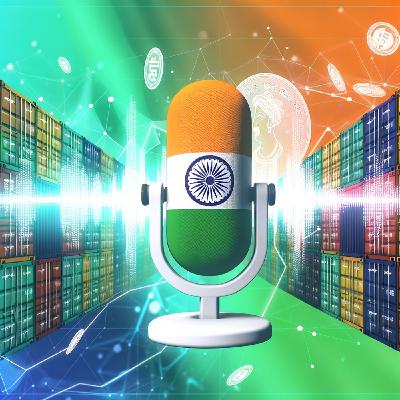US Doubles Tariffs on Indian Goods, Imposes $100,000 H-1B Visa Fee Amid Tense Trade Negotiations
Update: 2025-09-24
Description
Listeners, today’s top story: India and the United States remain locked in tense trade talks as a wave of new punitive tariffs threatens to reshape economic ties. The most pressing headline comes out of Washington, where controversial Trump tariffs on Indian goods have not only been doubled to a staggering 50% but have also been joined by a dramatic $100,000 H-1B visa fee impacting Indian tech professionals. According to Inconnect News, these tariffs, paired with costly visa restrictions, landed after the US cited India’s continued import of Russian crude oil as the chief reason—prompting the US to add a 25 percent penalty on top of the existing 25 percent tariff on select Indian exports.
Trade officials from both sides, including India’s Commerce Minister Piyush Goyal and chief negotiator Rajesh Agrawal, have been in marathon discussions with US counterparts in New York and Washington. The US Commerce Secretary Howard Lutnick and chief negotiator Brendan Lynch have been at the negotiating table. Both sides are pushing for a Bilateral Trade Agreement that could more than double commerce from the current $191 billion to $500 billion by 2030. The initial phase is targeted for conclusion by this autumn, yet the stubborn tariffs remain the biggest obstacle. The Economic Times reports that, despite positive signals from negotiators, Washington shows no intent to immediately roll back the penalties—even as India remains America’s largest trading partner for the fourth consecutive year.
The timing of Trump’s escalated tariff war has been seen by trade analysts as part of his signature negotiating style. The Indian Express highlights how the new tariffs and visa fees are likely aimed at leveraging India into a deal, just as similar tactics were used against Korea and the EU. On the Indian side, economic officials feel there are signs of potential softening; India’s Chief Economic Adviser V Anantha Nageswaran stated the additional 25 percent tariffs due to Russian oil “won’t continue beyond November 30” and backchannel negotiations look positive. Still, the US Treasury has called on G7 partners to further pressure buyers of Russian oil, underscoring persistent hawkishness.
Meanwhile, a recent meeting at the UN General Assembly between India’s External Affairs Minister S Jaishankar and US Senator Marco Rubio was notable for its lack of warmth, according to Inconnect News. Observers worry that the relentless tariffs and new visa hurdles could fracture the once-promising Modi-Trump partnership and damage India’s economic momentum. With an average effective US tariff rate hovering at 16.9% as of September 9th, per S&P Global’s Global Tariff Tracker, things are no less tense globally.
Listeners, thank you for tuning in to India Tariff News and Tracker. Remember to subscribe to stay updated as this crucial trade story develops. This has been a quiet please production, for more check out quiet please dot ai.
For more check out https://www.quietperiodplease.com/
Avoid ths tariff fee's and check out these deals https://amzn.to/4iaM94Q
This content was created in partnership and with the help of Artificial Intelligence AI
Trade officials from both sides, including India’s Commerce Minister Piyush Goyal and chief negotiator Rajesh Agrawal, have been in marathon discussions with US counterparts in New York and Washington. The US Commerce Secretary Howard Lutnick and chief negotiator Brendan Lynch have been at the negotiating table. Both sides are pushing for a Bilateral Trade Agreement that could more than double commerce from the current $191 billion to $500 billion by 2030. The initial phase is targeted for conclusion by this autumn, yet the stubborn tariffs remain the biggest obstacle. The Economic Times reports that, despite positive signals from negotiators, Washington shows no intent to immediately roll back the penalties—even as India remains America’s largest trading partner for the fourth consecutive year.
The timing of Trump’s escalated tariff war has been seen by trade analysts as part of his signature negotiating style. The Indian Express highlights how the new tariffs and visa fees are likely aimed at leveraging India into a deal, just as similar tactics were used against Korea and the EU. On the Indian side, economic officials feel there are signs of potential softening; India’s Chief Economic Adviser V Anantha Nageswaran stated the additional 25 percent tariffs due to Russian oil “won’t continue beyond November 30” and backchannel negotiations look positive. Still, the US Treasury has called on G7 partners to further pressure buyers of Russian oil, underscoring persistent hawkishness.
Meanwhile, a recent meeting at the UN General Assembly between India’s External Affairs Minister S Jaishankar and US Senator Marco Rubio was notable for its lack of warmth, according to Inconnect News. Observers worry that the relentless tariffs and new visa hurdles could fracture the once-promising Modi-Trump partnership and damage India’s economic momentum. With an average effective US tariff rate hovering at 16.9% as of September 9th, per S&P Global’s Global Tariff Tracker, things are no less tense globally.
Listeners, thank you for tuning in to India Tariff News and Tracker. Remember to subscribe to stay updated as this crucial trade story develops. This has been a quiet please production, for more check out quiet please dot ai.
For more check out https://www.quietperiodplease.com/
Avoid ths tariff fee's and check out these deals https://amzn.to/4iaM94Q
This content was created in partnership and with the help of Artificial Intelligence AI
Comments
In Channel





